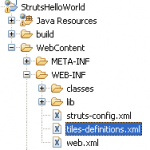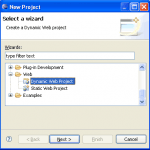The web application created by using Struts framework can be easily identified by the URL patterns. Mostly all the Struts application have *.do or *.action URL depending on the version of Struts being used and the best practices that are followed. These URLs are less search engine friendly as they reveal very little about the content. Hence it can be useful to implement a web application with clean URLs pattern such as /custormer/add or /profile/william. This can be achieved in Struts by modifying Web.xml and struts-config.xml files. Following is the ActionServlet entry that is normally made in Web.xml file in order to configure struts.
<servlet>
<servlet-name>action</servlet-name>
<servlet-class>org.apache.struts.action.ActionServlet</servlet-class>
<init-param>
<param-name>config</param-name>
<param-value>/WEB-INF/struts-config.xml</param-value>
</init-param>
<init-param>
<param-name>debug</param-name>
<param-value>2</param-value>
</init-param>
<init-param>
<param-name>detail</param-name>
<param-value>2</param-value>
</init-param>
<load-on-startup>2</load-on-startup>
</servlet>
<servlet-mapping>
<servlet-name>action</servlet-name>
<url-pattern>*.do</url-pattern>
</servlet-mapping>
Code language: HTML, XML (xml)<servlet>
<servlet-name>action</servlet-name>
<servlet-class>
org.apache.struts.action.ActionServlet
</servlet-class>
<init-param>
<param-name>config</param-name>
<param-value>/WEB-INF/struts-config.xml</param-value>
</init-param>
<init-param>
<param-name>debug</param-name>
<param-value>2</param-value>
</init-param>
<init-param>
<param-name>detail</param-name>
<param-value>2</param-value>
</init-param>
<init-param>
<param-name>chainConfig</param-name>
<param-value>
org/apache/struts/tiles/chain-config.xml
</param-value>
</init-param>
<load-on-startup>2</load-on-startup>
</servlet>
<!-- Extension mappings to static content -->
<servlet-mapping>
<servlet-name>default</servlet-name>
<url-pattern>*.css</url-pattern>
</servlet-mapping>
<servlet-mapping>
<servlet-name>default</servlet-name>
<url-pattern>*.js</url-pattern>
</servlet-mapping>
<servlet-mapping>
<servlet-name>default</servlet-name>
<url-pattern>*.png</url-pattern>
</servlet-mapping>
<servlet-mapping>
<servlet-name>default</servlet-name>
<url-pattern>*.jpg</url-pattern>
</servlet-mapping>
<servlet-mapping>
<servlet-name>default</servlet-name>
<url-pattern>/index.jsp</url-pattern>
</servlet-mapping>
<servlet-mapping>
<servlet-name>action</servlet-name>
<url-pattern>/</url-pattern>
</servlet-mapping>
Code language: HTML, XML (xml)<action path="/login" name="userBean" scope="request"
validate="true" input="/index.jsp"
type="net.viralpatel.sturts.cleanurl.LoginAction">
<forward name="success" path="/home" />
<forward name="fail" path="/index.jsp" />
</action>
<action path="/home" name="userBean" scope="request"
validate="true" input="/index.jsp"
type="net.viralpatel.sturts.cleanurl.HomeAction">
<forward name="success" path="/home.jsp" />
<forward name="fail" path="/home.jsp" />
</action>
<action path="/profile/save" name="profileForm" scope="request"
validate="false" input="/profile.jsp"
type="net.viralpatel.sturts.cleanurl.ProfileAction">
<forward name="success" path="/profile.jsp" />
<forward name="fail" path="/profile.jsp" />
</action>
Code language: HTML, XML (xml)<action path="/profile/*"
type="net.viralpatel.struts.cleanurl.ProfileAction"
parameter="{1}">
<forward name="success" path="/profile.jsp" />
<forward name="fail" path="/profile.jsp" />
</action>
Code language: HTML, XML (xml)public ActionForward process(ActionMapping mapping, ActionForm actionForm,
HttpServletRequest request, HttpServletResponse response)
throws NoRecordFoundException {
String parameter = mapping.getParameter();
...
}
Code language: Java (java)


Hi,
This was a very good article for struts developers to provide a search engine friendly urls.
If the application has struts and spring, how can we provide the wildcard in spring action bean definitions.
Hi Guru,
I had not chance to add this functionality in a Strut-Spring based application. I will soon update this tutorial.
Thanks
Hi,
Thanks for the idea.
I think your old links like “page.do?param=12” would not be fonctional anymore!
Unless you duplicate actions in struts-config.xml.
I made this implementation of cleaning Struts URLs to become more friendly by imposing a Filter that treats clean url’s and then redirects to the old Struts url.That worked smoothly.
Thanks
MS
Thanks Matt for your comments.
This technique can be applied if we are writing any application from scratch. But if we have to migrate an existing application, it becomes a little tedious.
Hi, It was good reading your post! I’ve been hearing about John Beck’s program these days. My colleague also purchased the system to use it as a side business work.
Nice article, I had seen such clean URL mapping at work and wondered why they had used the wild card * to map URLs to action classes, now I know. Might not use it myself but good to know.
Offtopic, ViralPatel I would like to see some more articles on Spring – thanks.
Nice article, but when i use is my page lost the path of css or jquery. original css\mycss.css. jsp page recognize normally. but when i use /profile/john/friends i must redefine css or jquerrt link again looklike as ../../css/mycss.css could you please give my any solution.
hii viral , i want from u just aded some project in struts aand hibernate
Nice work. Thanks. But i have a doubt,can we handle dispatch action in this way?
Hello!
Nice article! I just have one question. How can we nicely/easily use clean URLs with html forms?
Example: let’s say we have a search page with a input text box, and after searching on ‘table’, I would like to have the URL ‘xxx.com/search/table’? How would the form look like?
With default struts URLs, it looks something like this:
Exactly what I have been looking for .. The explanation was clear and perfect
Very nice! btw, is this also available for structs 1?
is it possible to do url mapping using only jsp without servlet